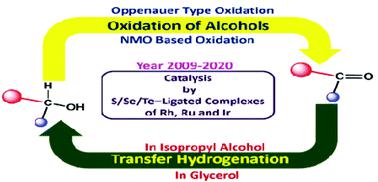当前位置:
X-MOL 学术
›
Dalton Trans.
›
论文详情
Our official English website, www.x-mol.net, welcomes your
feedback! (Note: you will need to create a separate account there.)
Organochalcogen ligands in catalysis of oxidation of alcohols and transfer hydrogenation.
Dalton Transactions ( IF 3.5 ) Pub Date : 2020-08-11 , DOI: 10.1039/d0dt01201g Preeti Oswal 1 , Aayushi Arora 1 , Siddhant Singh 1 , Divyanshu Nautiyal 1 , Sushil Kumar 1 , Gyandshwar Kumar Rao 2 , Arun Kumar 1
Dalton Transactions ( IF 3.5 ) Pub Date : 2020-08-11 , DOI: 10.1039/d0dt01201g Preeti Oswal 1 , Aayushi Arora 1 , Siddhant Singh 1 , Divyanshu Nautiyal 1 , Sushil Kumar 1 , Gyandshwar Kumar Rao 2 , Arun Kumar 1
Affiliation

|
Organochalcogen compounds have been used as the building blocks for the development of a variety of catalysts that have been studied comprehensively during the last two decades for several chemical transformations. Transfer hydrogenation (reduction of carbonyl compounds to alcohols) and oxidation of alcohols (conversion of alcohols to their respective ketones and aldehydes) are also among such chemical transformations. Some compilations are available in the literature on the development of catalysts, based on organochalcogen ligands, and their applications in Heck reaction, Suzuki reaction, and other related aspects. Some review articles have also been published on different aspects of oxidation of alcohols and transfer hydrogenation. However, no such article is available in the literature on the syntheses and use of organochalcogen ligated catalysts for these two reactions. In this perspective, a survey of developments pertaining to the synthetic aspects of such organochalcogen (S/Se/Te) based catalysts for the two reactions has been made. In addition to covering the syntheses of chalcogen ligands, their metal complexes and nanoparticles (NPs), emphasis has also been placed on the efficient conversion of different substrates during catalytic reactions, diversity in catalytic potential and mechanistic aspects of catalysis. It also includes the analysis of comparison (in terms of efficiency) between this unique class of catalysts and efficient catalysts without a chalcogen donor. The future scope of this area has also been highlighted.
中文翻译:

有机氧碳配体催化醇的氧化和转移氢化。
在过去的二十年中,有机碳氢化合物已被用作开发各种催化剂的基础材料,这些催化剂在过去的几十年中已经进行了多次化学转化的全面研究。这种化学转化也包括转移氢化(将羰基化合物还原为醇)和氧化醇(将醇转化为它们各自的酮和醛)。基于有机硫属元素配体的催化剂的开发及其在Heck反应,Suzuki反应和其他相关方面的应用,在文献中可获得一些汇编。一些评论文章也已发表,涉及醇氧化和转移氢化的不同方面。然而,在这两个反应的文献中,没有关于有机硫属化合物连接的催化剂的合成和用途的此类文章。从这个角度出发,已经进行了关于用于两个反应的这种基于有机硫属元素(S / Se / Te)的催化剂的合成方面的进展的综述。除了涵盖硫属元素配体,其金属配合物和纳米颗粒(NP)的合成外,还重点关注催化反应过程中不同底物的有效转化,催化潜力的多样性和催化机理。它还包括分析这种独特类型的催化剂与没有硫属元素供体的高效催化剂之间的比较(就效率而言)。该领域的未来范围也得到了强调。进行了有关这种有机硫属元素(S / Se / Te)基催化剂在两个反应中合成方面的研究进展的综述。除了涵盖硫属元素配体,其金属配合物和纳米颗粒(NP)的合成外,还重点关注催化反应过程中不同底物的有效转化,催化潜力的多样性和催化机理。它还包括分析这种独特类型的催化剂与没有硫属元素供体的高效催化剂之间的比较(就效率而言)。该领域的未来范围也得到了强调。进行了有关这种有机硫属元素(S / Se / Te)基催化剂在两个反应中合成方面的研究进展的综述。除了涵盖硫属元素配体,其金属配合物和纳米颗粒(NP)的合成外,还重点关注催化反应过程中不同底物的有效转化,催化潜力的多样性和催化机理。它还包括分析这种独特类型的催化剂与没有硫属元素供体的高效催化剂之间的比较(就效率而言)。该领域的未来范围也得到了强调。它们的金属络合物和纳米颗粒(NPs)的重点还在于催化反应过程中不同底物的有效转化,催化电位的多样性和催化机理。它还包括分析这种独特类型的催化剂与没有硫属元素供体的高效催化剂之间的比较(就效率而言)。该领域的未来范围也得到了强调。它们的金属络合物和纳米颗粒(NPs)的重点还在于催化反应过程中不同底物的有效转化,催化电位的多样性和催化机理。它还包括分析这种独特类型的催化剂与没有硫属元素供体的高效催化剂之间的比较(就效率而言)。该领域的未来范围也得到了强调。
更新日期:2020-09-22
中文翻译:

有机氧碳配体催化醇的氧化和转移氢化。
在过去的二十年中,有机碳氢化合物已被用作开发各种催化剂的基础材料,这些催化剂在过去的几十年中已经进行了多次化学转化的全面研究。这种化学转化也包括转移氢化(将羰基化合物还原为醇)和氧化醇(将醇转化为它们各自的酮和醛)。基于有机硫属元素配体的催化剂的开发及其在Heck反应,Suzuki反应和其他相关方面的应用,在文献中可获得一些汇编。一些评论文章也已发表,涉及醇氧化和转移氢化的不同方面。然而,在这两个反应的文献中,没有关于有机硫属化合物连接的催化剂的合成和用途的此类文章。从这个角度出发,已经进行了关于用于两个反应的这种基于有机硫属元素(S / Se / Te)的催化剂的合成方面的进展的综述。除了涵盖硫属元素配体,其金属配合物和纳米颗粒(NP)的合成外,还重点关注催化反应过程中不同底物的有效转化,催化潜力的多样性和催化机理。它还包括分析这种独特类型的催化剂与没有硫属元素供体的高效催化剂之间的比较(就效率而言)。该领域的未来范围也得到了强调。进行了有关这种有机硫属元素(S / Se / Te)基催化剂在两个反应中合成方面的研究进展的综述。除了涵盖硫属元素配体,其金属配合物和纳米颗粒(NP)的合成外,还重点关注催化反应过程中不同底物的有效转化,催化潜力的多样性和催化机理。它还包括分析这种独特类型的催化剂与没有硫属元素供体的高效催化剂之间的比较(就效率而言)。该领域的未来范围也得到了强调。进行了有关这种有机硫属元素(S / Se / Te)基催化剂在两个反应中合成方面的研究进展的综述。除了涵盖硫属元素配体,其金属配合物和纳米颗粒(NP)的合成外,还重点关注催化反应过程中不同底物的有效转化,催化潜力的多样性和催化机理。它还包括分析这种独特类型的催化剂与没有硫属元素供体的高效催化剂之间的比较(就效率而言)。该领域的未来范围也得到了强调。它们的金属络合物和纳米颗粒(NPs)的重点还在于催化反应过程中不同底物的有效转化,催化电位的多样性和催化机理。它还包括分析这种独特类型的催化剂与没有硫属元素供体的高效催化剂之间的比较(就效率而言)。该领域的未来范围也得到了强调。它们的金属络合物和纳米颗粒(NPs)的重点还在于催化反应过程中不同底物的有效转化,催化电位的多样性和催化机理。它还包括分析这种独特类型的催化剂与没有硫属元素供体的高效催化剂之间的比较(就效率而言)。该领域的未来范围也得到了强调。











































 京公网安备 11010802027423号
京公网安备 11010802027423号